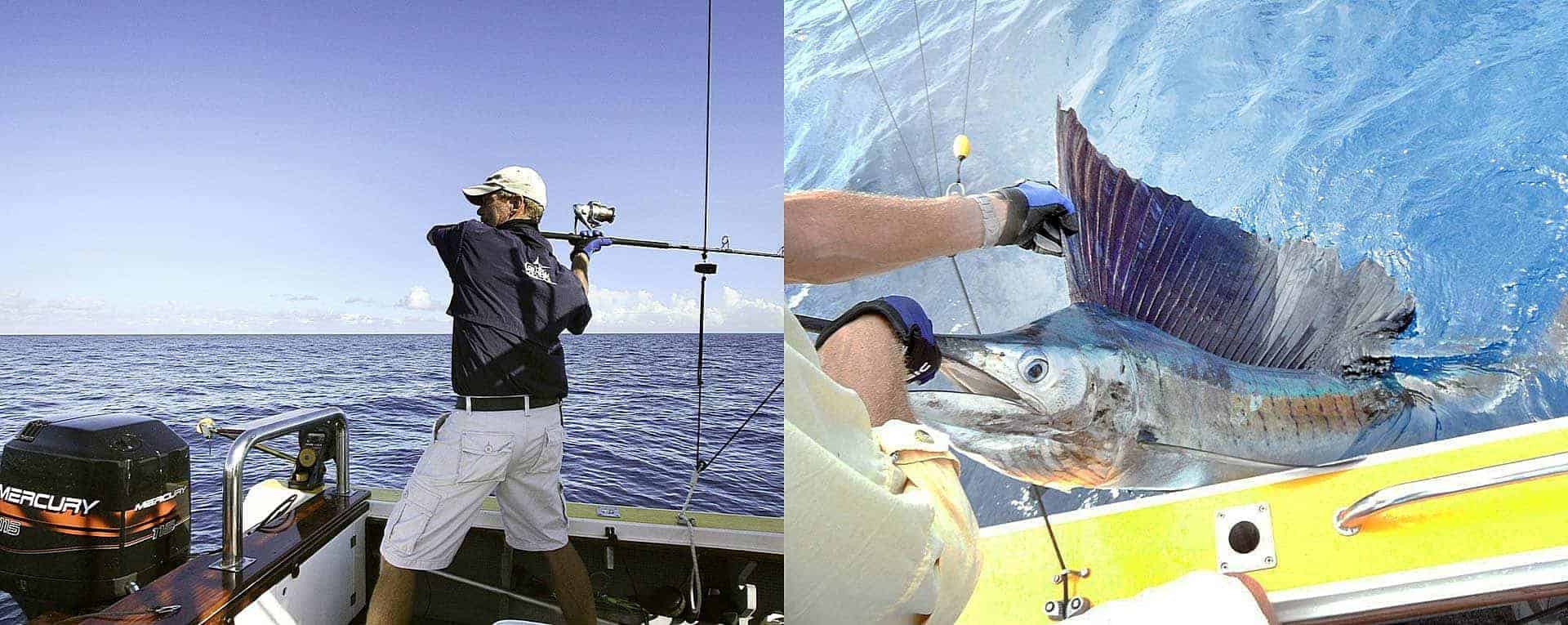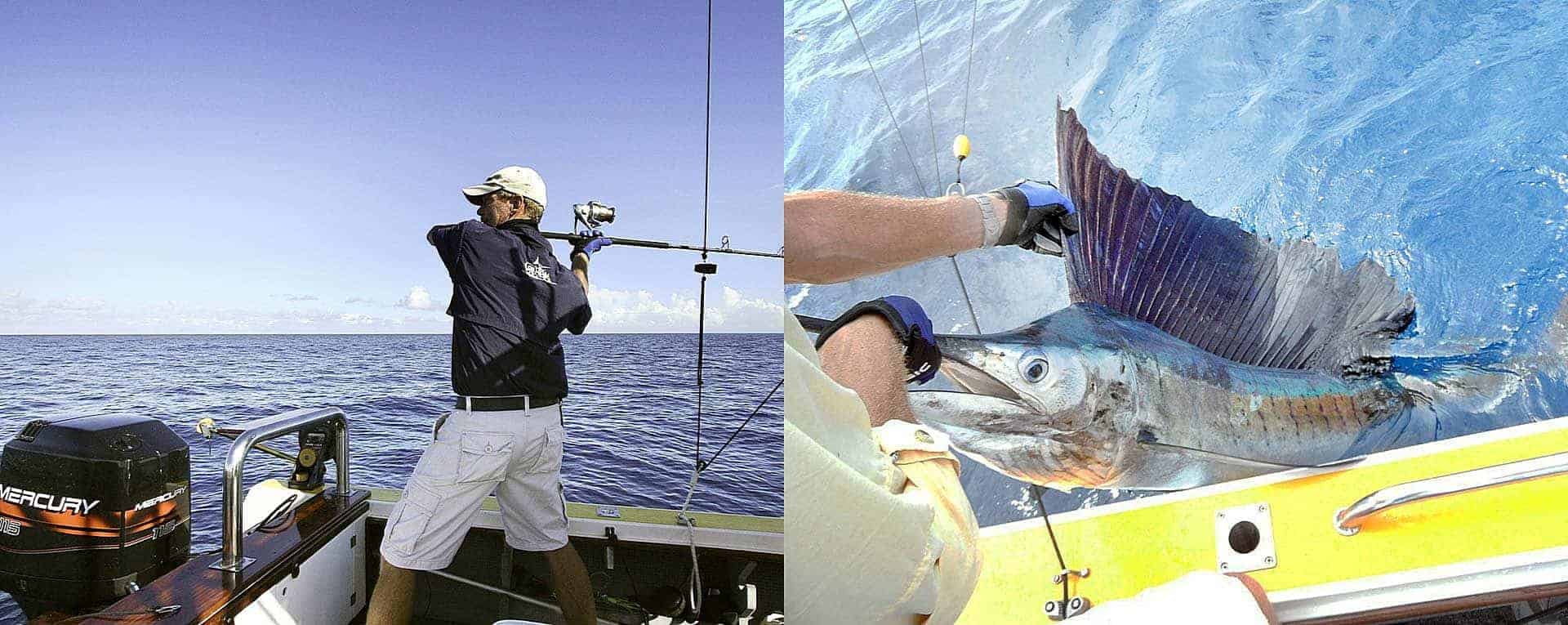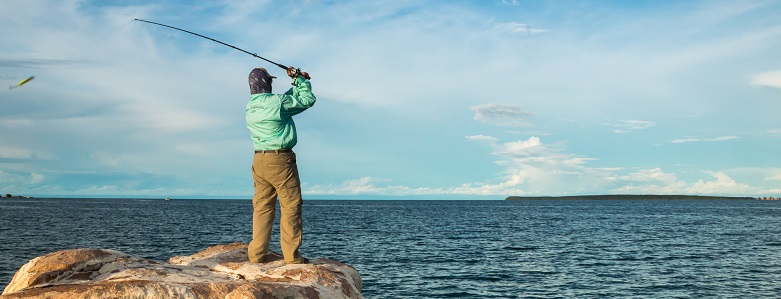Fishing in Tanzania : Fishing is one of the most popular tourist activities in Tanzania that most visitors enjoy. Fishing in Tanzania’s rivers, lakes, and oceans is an amazing experience that all visitors to the country should have. Tanzania is one of the few destinations blessed with a large percentage of water bodies such as rivers, lakes, swamps, and the ocean, all of which combine to make Tanzania one of the most pleasurable tourist destinations for marine sports such as boating, canoeing, and fishing. Tanzania offers a variety of fishing opportunities, the majority of which are sea fishing along the immensely rich East African coast.

Fishing in the deep sea
Big-game fish abound in the deep seas of the Indian Ocean off Tanzania’s coast, from marlin and tuna to swordfish and biting barracudas. Nonetheless, Tanzania’s seas are only now beginning to earn the international acclaim of Kenya’s coast, so the waters are less crowded and fishing is at its best. Tuna and other pelagic fish move through the Pemba Channel every year, but smaller quantities can be found throughout the year. Aside from big game fish, the coastal waters are abundant with grouper, red snapper, and other native species. Private organizations that specialize in boats and ocean tours, such as Focus East Africa Tours, are the ideal places to go deep sea fishing in Tanzania.
Pangani and Dar es Salaam are the most popular deep-sea fishing destinations along the continental coast. The Pemba Channel, a major migratory corridor for big-game pelagic, is easily accessible from Pangani and Tanga. Focus East Africa Tours, based in the Zanzibar Archipelago, offers deep-sea fishing charters.
Fishing is gaining popularity as a substitute for snorkeling and diving vacations around the reefs. Clients are taken out on boats to explore the Pemba Channel and the surroundings. Pelagic and big-game fish are abundant in the isolated waters around Pemba and Unguja and reward the adventurous fishermen with their size and bounty.

Fishing on the inland waters
Fishing is an important source of income in many rural areas of Tanzania, and it is gradually becoming a major tourist attraction along the country’s rivers and lakes. Although it is not authorized in national parks, lake fishing in rural locations is a pleasant and tranquil way to explore the grandeur of the African countryside at a slow pace. Day visits to local lakes and rivers can be arranged through East Africa Tours, as can extended fishing Tanzania safaris around the region if desired.
Tanzania’s freshwater lakes provide fishing chances for anyone willing to go off the main path. Fishing in Lake Victoria allows you to experience freshwater lake fishing while also observing life around Tanzania’s lakes. Rubondo Island National Park can also be used as a base for cruises throughout Lake Victoria and its tributaries. A fishing voyage can be planned at any time following the short and lengthy rains.
WHERE TO GO FOR FISHING
Dar es Salaam City
This is one of Tanzania’s most attractive fishing destinations, where visitors can enjoy and experience fantastic sport fishing as well as a breathtaking view of the Indian Ocean.
Dar es Salaam is Tanzania’s largest city and economic hub. The city, which is located in a calm bay off the coast of the Indian Ocean, has grown in economic prominence to become a thriving center for the entire East African region. Tanzania’s main port is located in this bustling city.
Bongoyo Island Marine Reserve, located a few kilometers north of the city, is a good snorkeling and diving spot for those who want to get out into the sea. The reserve is known for its stunning beaches, hidden islets, and diverse marine life. The Bongoyo Island Marine Reserve is definitely worth a visit and is a terrific way to spend a day out and view the coast, despite the lack of variety and population of coral and fish species compared to other places on Zanzibar, Pemba, and Mafia Island.
Saadani National Park
Saadani, another popular fishing spot in Tanzania, is where the beach meets the bush. It is the only wildlife reserve in East Africa with an Indian Ocean beachfront, and it also has all of the characteristics that make Tanzania’s tropical coastline and islands so popular with European sun worshippers. However, it is the only site where those leisurely hours of sunbathing might be interrupted by an elephant strolling by or a lion approaching the local waterhole to drink.
One can enjoy the palm trees in Saadan National Park as they sway in the cool seaside breeze. Saadani is a wonderful spot to visit, with its white beach and blue water glistening alluringly under the tropical heat and a magnificent red sunrise, traditional Swahili fishermen cast their nets.
Rubondo Island National Park
Rubondo Island and numerous other small islands in Lake Victoria are located on the south-west coasts of the lake. Visitors to Lake Victoria’s Rubondo Island National Park will have the option of going spot fishing in the world’s second largest freshwater lake. During this exceptional action, Nile perch weighing up to 100 kg can be caught. Come with Focus East Africa Tours and see what this exercise is all about.

Lake Victoria is Africa’s largest lake and home to an abundance of Nile perch and tilapia. Rubondo Island is a quiet but unmissable fishing spot in Tanzania. Glide along gently on your own private fishing boat, accompanied by a skilled and knowledgeable fishing guide with Focus East Africa Tours, as you enjoy a cool drink and watch the water birds roost for the night against the backdrop of the sun setting over the sea.
Aside from fishing, a trip to Rubondo Island National Park allows guests to take a break from game viewing and relax in the serenity of a lakeside setting. Day trips are made more exciting by exploring the park’s islands. Focus East Africa Tours can easily arrange fishing trips on Rubondo Island.
Lake Victoria
Lake Victoria is Africa’s largest lake, covering 68,800 square kilometers (26,600 square miles). It’s also the world’s largest tropical lake and the world’s second-largest freshwater lake.
Its shores, save on the west, are deeply concave giving it an irregular quadrilateral shape. Its longest length is 210 miles (337 kilometers) from north to south, while its greatest breadth is 150 miles (240 km). It has a coastline of over 2,000 kilometers (3,220 km). Its waters flow into a shallow depression in the middle of the huge plateau that connects the Western and Eastern Rift Valleys.
There are around 200 fish species in Lake Victoria, with tilapia being the most economically important. Due to its enormous variety of fish species, Lake Victoria is Tanzania’s most famous and essential fishing destination. The stunning sunsets and sunshine make fishing even more incredible and pleasurable. It’s a must-visit location for fishing in Tanzania.
Matema Beach Town
Matema Beach is a seaside hamlet in the Mbeya Region of Tanzania. It is located on the glorious shores of Lake Nyasa and is one of Tanzania’s most gorgeous tourist attractions and fishing sites.
The lakefront beach is located in the foothills and end point of the Livingstone Mountains, where these magnificent peaks meet Lake Nyasa spectacularly.
The journey to Matema Beach is filled with breathtaking vistas of true African life as lived by the locals. Before descending to the tropical shores of Lake Nyasa, a winding road travels through the high Livingstone Mountains and tea gardens.
You may take canoe journeys across the lake with fishermen from Matema Beach to a small village where the ladies are specialize in ceramics. There is a fantastic snookering rocky shoreline as well as a Livingstone Mountains waterfall.
Matema, a lakeside village, is a fishing community where local fisherman sell their catches. During German control in Tanzania, the settlement was the regional headquarters of the German Governor until mosquitoes pushed him and his entourage away.
The beach has a long stretch of soft sand with a lovely view of the horizon and the clean, sparkling water of Lake Nyasa. It provides opportunities for water sports, ornamental fish observation, water surfing, diving, and seaside recreation. The most stunning feature of Matema Beach town is the amazing view of the Livingstone Mountains as they descend majestically into Lake Nyasa.
Lake Tanganyika
Lake Tanganyika is the world’s longest (660 kilometers), deepest in Africa (over 1436 meters), and second-largest (by volume) freshwater lake. It’s also one of the oldest, dating back between nine and thirteen million years. Its antiquity and ecological isolation were important factors because it is home to an exceptional number of unique fish, including 98 percent of the 250-plus species of cichlids. Tanganyika is an excellent fishing, snorkeling, and diving destination in Tanzania because of its abundance of cichlids, which are popular aquarium fish due to their vibrant colors.

Lake Tanganyika is located on the border between eastern and western Africa’s floral regions, and oil palms, which are typical of western Africa’s flora, flourish along the lake’s shores. Along the coastlines, rice and subsistence crops are farmed, and fishing is important. Hippopotamuses and crocodiles abound, as does a diverse avian population.
Many of the many people (mostly Bantu-speaking) that live along the lake’s eastern shores can trace their roots back to the Congo River basin. The lake was first discovered by Europeans in 1858, when British explorers Sir Richard Burton and John Hanning Speke arrived at Ujiji on the lake’s eastern bank in search of the Nile River’s source.
Ukerewe Island
With an area of over 530 km2, Ukerewe is the largest island in Lake Victoria and Africa’s largest inland island. Ukerewe Island is located in the Ukerewe District, nearly 50 kilometers north of Mwanza, and it takes 3 to 4 hours to get there by ferry.
Ukerewe Island is ringed by at least a dozen smaller islands, and its shoreline is cut into multiple bays. Ukerewe Island’s shoreline is carved into multiple bays, and it is bordered by 27 small islands, three of which are uninhabited by people, and the rest of which are inhabited by fishermen and their families. Agricultural activities, such as maize, sweet potatoes, millet, cassava, and rice farming, as well as the major activity here, fishing, are among the few proper sights.
Apart from fishing, visitors to Ukerewe can enjoy amazing views of Mwanza city, Entebbe in Uganda, and Nairobi in Kenya from Irondo Point; a chance to be a part of the Buzegwe staff band, a traditional dance group that is sure to captivate you; and a visit to historic sites, including graves in the area.
Zanzibar Island
The lovely island of Zanzibar on Africa’s east coast is known as the Spice Island, and it is brimming with culture and history, seemingly at odds with its perfect landscape of white-sand beaches and palm trees swaying gently in the sea air. As a result of all of this, Zanzibar is a fantastic area to explore as well as a wonderful spot to relax and unwind.
Pangani Town
Pangani is a small town on the East African coast, 50 kilometers south of Tanga, with a lengthy history and culture influenced by Arabic, German, Asian, and British colonial authorities. This is a site where Swahili, Arab, and colonial traditions mingle with modern hospitality.
This hamlet is situated at the mouth of the Pangani River, which collects water from Mt. Kilimanjaro and Meru and discharges it into the Indian Ocean. You may enjoy clean beaches where endangered green turtles lay their eggs, historic sites, coral reefs, the Old Port, and a wide variety of tropical aquatic life.
A community has arisen near the mouth of the enormous Pangani River, which empties into the Indian Ocean. The Pangani River divides the old buildings and the modern market on the northern side of town from the fields and tiny dwellings on the southern side. The river itself requires a ferry to cross, as it meanders slowly into the ocean, its dark brown waters heavy with alluvial sediment. Coconut trees and sisal plantations undulate to the horizon on both sides of the small town.
Mafia Island Marine Park
The park encompasses the southern portion of Mafia Island and includes the populated islands of Chole, Juani, Jibondo, and Bwejuu, as well as several uninhabited islets and the waters surrounding them. Mafia Island provides a best fishing site that makes visitors blows their minds, arrange and organize your fishing trip today in Mafia island With Focus East Africa Tours for better and expected experience
Mafia Island and its chain of small islets are located 120 kilometers south of Dar es Salaam and 20 kilometers offshore from the Rufiji Delta, Africa’s largest delta system. The Indian Ocean lies to the east of Mafia Island. Mafia’s main island is around 48 kilometers long and 17 kilometers wide at its widest point. To the west and south, there are several smaller islands and islets.


